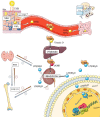Vitamin D metabolism and extraskeletal outcomes: an update
- PMID: 36382764
- PMCID: PMC10118817
- DOI: 10.20945/2359-3997000000565
Vitamin D metabolism and extraskeletal outcomes: an update
Abstract
Vitamin D deficiency is a general health problem affecting individuals at all stages of life and on different continents. The musculoskeletal effects of vitamin D are well known. Its deficiency causes rickets, osteomalacia, and secondary hyperparathyroidism and increases the risk of fractures. Clinical and experimental evidence suggests that vitamin D performs multiple extraskeletal functions. Several tissues unrelated to calcium and phosphate metabolism express vitamin D receptor (VDR) and are directly or indirectly influenced by 1,25(OH)2D (calcitriol). Some also express the enzyme 1 alpha-hydroxylase (CYP27B1) and produce 1,25(OH)2D, inducing autocrine or paracrine effects. Among the pleiotropic effects of vitamin D are the regulation of cell proliferation and differentiation, hormone secretion, and immune function. In this review, we outline vitamin D physiology and the outcomes of recent large RCTs on its potential extraskeletal effects. Those studies exhibit a need for continued clinical analysis to elucidate whether vitamin D status can influence extraskeletal health. Longer longitudinal follow-up and standardized assays are crucial to better assess potential outcomes.
Keywords: Vitamin D; randomized controlled trial; vitamin D/metabolism; vitamin D/physiology; vitamin D/therapeutic use.
Conflict of interest statement
Disclosure: no potential conflict of interest relevant to this article was reported.
Figures


References
-
- Pereira-Santos M, Santos JYGD, Carvalho GQ, Santos DBD, Oliveira AM. Epidemiology of vitamin D insufficiency and deficiency in a population in a sunny country: Geospatial meta-analysis in Brazil. Crit Rev Food Sci Nutr. 2019;59(13):2102–2109. - PubMed
-
- Leal ACGB, Corrêa MP, Holick MF, Melo EV, Lazaretti-Castro M. Sun-induced production of vitamin D3 throughout 1 year in tropical and subtropical regions: relationship with latitude, cloudiness, UV-B exposure and solar zenith angle. Photochem Photobiol Sci. 2021;20(2):265–274. - PubMed
-
- Maeda SS, Borba VZC, Camargo MBR, Silva DMW, Borges JLC, Bandeira F, et al. Recomendações da Sociedade Brasileira de Endocrinologia e Metabologia (SBEM) para o diagnóstico e tratamento da hipovitaminose D. Arq Bras Endocrinol Metabol. 2014;58(5):411–433. - PubMed
-
- Moreira C, Leão R, Júnior, Moreira CA, Madeira M, Campolina B, Silva C, et al. Reference values of 25-hydroxyvitamin D revisited: a position statement from the Brazilian Society of Endocrinology and Metabolism (SBEM) and the Brazilian Society of Clinical Pathology/Laboratory Medicine (SBPC) Available from: https://orcid.org/0000-0001-9186-2834. - PMC - PubMed
Publication types
MeSH terms
Substances
LinkOut - more resources
Full Text Sources
Medical
